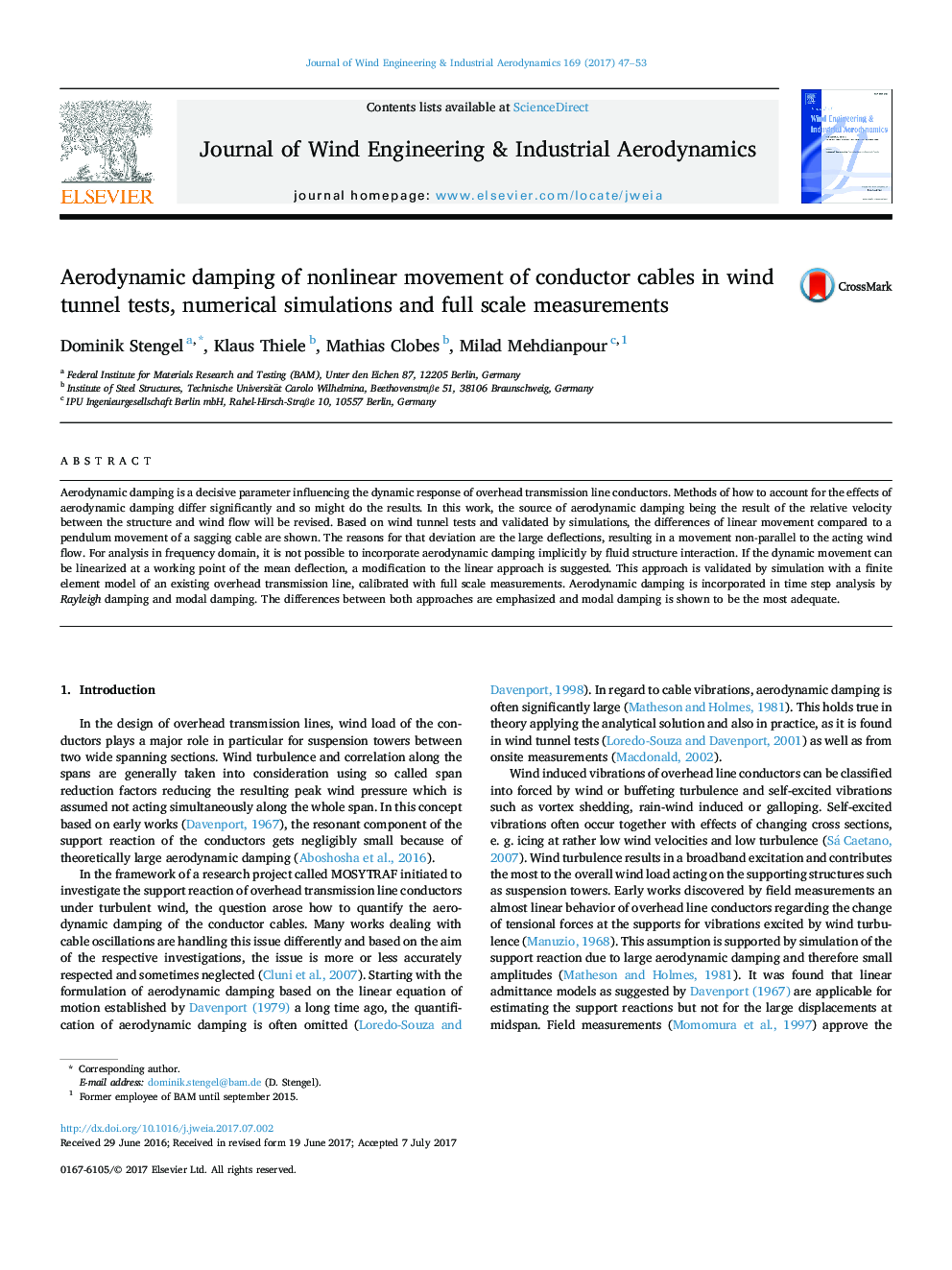| کد مقاله | کد نشریه | سال انتشار | مقاله انگلیسی | نسخه تمام متن |
|---|---|---|---|---|
| 4924839 | 1431097 | 2017 | 7 صفحه PDF | دانلود رایگان |
عنوان انگلیسی مقاله ISI
Aerodynamic damping of nonlinear movement of conductor cables in wind tunnel tests, numerical simulations and full scale measurements
ترجمه فارسی عنوان
کاهش آیرودینامیکی حرکت غیرخطی کابل های هادی در آزمون تونل باد، شبیه سازی های عددی و اندازه گیری مقیاس کامل
دانلود مقاله + سفارش ترجمه
دانلود مقاله ISI انگلیسی
رایگان برای ایرانیان
ترجمه چکیده
مهار آیرودینامیکی یک پارامتر تعیین کننده است که بر پاسخ دینامیکی خطوط انتقال خطوط هوایی تأثیر می گذارد. روش های نحوه محاسبه اثرات سقوط آیرودینامیکی به طور قابل توجهی متفاوت است و بنابراین می تواند نتایج را انجام دهد. در این کار منبع انقباض آیرودینامیکی که نتیجه سرعت نسبی بین ساختار و جریان باد است تجدید نظر خواهد شد. بر اساس آزمون تونل های باد و با شبیه سازی های معتبر، تفاوت های حرکت خطی در مقایسه با حرکت آونگ از یک کابل تضعیف نشان داده شده است. دلایل این انحراف، انحرافات بزرگ است، که منجر به یک حرکت غیر موازی با جریان باد می شود. برای تجزیه و تحلیل در دامنه فرکانس، ممکن است به طور ضمنی با استفاده از تعامل ساختار سیال، سقوط آیرودینامیکی را شامل شود. اگر حرکت دینامیکی را می توان در یک نقطه کار از میانگین انحراف خطی کرد، یک اصلاح در روش خطی پیشنهاد شده است. این رویکرد با شبیه سازی با یک مدل عنصر محدود از یک خط انتقال سربار موجود، با کالیبراسیون با اندازه گیری کامل مقیاس، معتبر است. محرک آیرودینامیکی در تحلیل گام زمان توسط ریمل ریلی و مهار مودال گنجانده شده است. تفاوت بین هر دو رویکرد تاکید شده است و نشان داده شده است که کمینه شدن مودال کافی است.
موضوعات مرتبط
مهندسی و علوم پایه
مهندسی انرژی
انرژی های تجدید پذیر، توسعه پایدار و محیط زیست
چکیده انگلیسی
Aerodynamic damping is a decisive parameter influencing the dynamic response of overhead transmission line conductors. Methods of how to account for the effects of aerodynamic damping differ significantly and so might do the results. In this work, the source of aerodynamic damping being the result of the relative velocity between the structure and wind flow will be revised. Based on wind tunnel tests and validated by simulations, the differences of linear movement compared to a pendulum movement of a sagging cable are shown. The reasons for that deviation are the large deflections, resulting in a movement non-parallel to the acting wind flow. For analysis in frequency domain, it is not possible to incorporate aerodynamic damping implicitly by fluid structure interaction. If the dynamic movement can be linearized at a working point of the mean deflection, a modification to the linear approach is suggested. This approach is validated by simulation with a finite element model of an existing overhead transmission line, calibrated with full scale measurements. Aerodynamic damping is incorporated in time step analysis by Rayleigh damping and modal damping. The differences between both approaches are emphasized and modal damping is shown to be the most adequate.
ناشر
Database: Elsevier - ScienceDirect (ساینس دایرکت)
Journal: Journal of Wind Engineering and Industrial Aerodynamics - Volume 169, October 2017, Pages 47-53
Journal: Journal of Wind Engineering and Industrial Aerodynamics - Volume 169, October 2017, Pages 47-53
نویسندگان
Dominik Stengel, Klaus Thiele, Mathias Clobes, Milad Mehdianpour,
